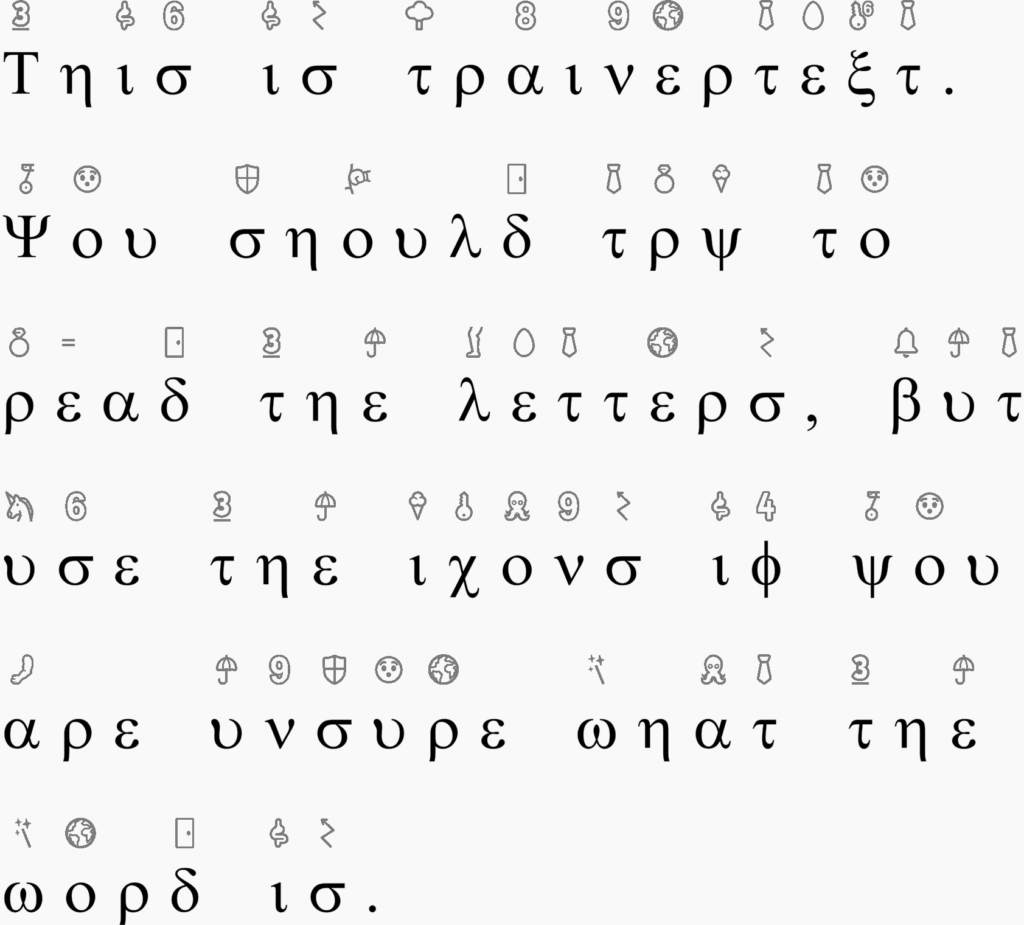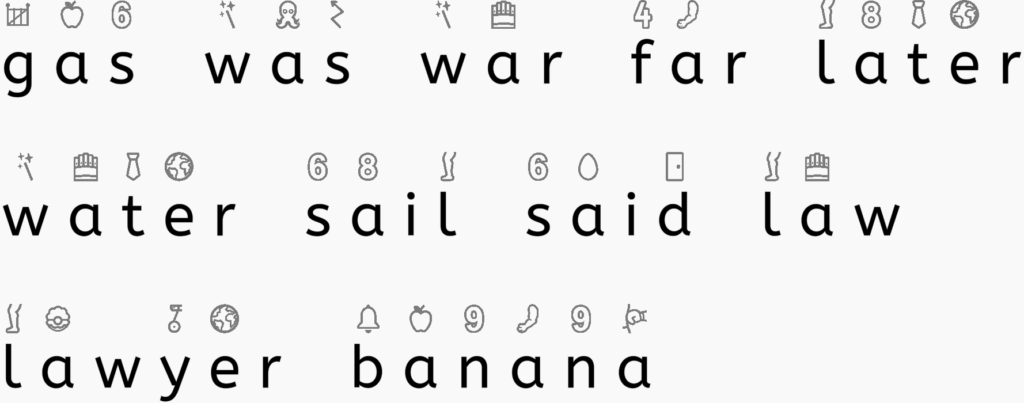What is Trainertext?
The principal to trainertext is incredibly simple. Say a word has three sounds in it. In trainertext you will see three little icons to indicate what those three sounds are.
Each sounds is called a ‘phoneme’. And the letter or letters representing an individual phoneme is called a ‘grapheme’. The icon above the grapheme is called a ‘pictophone’. The presence of the pictophones means that the learner always knows what the sounds are in a word.
This changes reading practice fundamentally, because the learner never gets stuck. They can always ‘decode’ the word, even if it is completely irregular and unfamiliar.
Here is a simple example. You can see how ‘cove’ is regular and has the omega above the letter O. ‘Love’ us the umbrella above the O and ‘move’ has the ooh! face.


How does it work?
The learner begins to read some text. If they can decode the letters to sounds and blend the sounds into words, all is well. But once they hit a tricky word, the trainertext comes into play.
Tricky words are often a barrier, even if they have been read quite read quite recently. So the learner’s stress begins to rise, because they cannot work out what the word is. Then they probably guess it.
But with trainertext, the learner can work out the words and progress. Reading practice becomes a moment of success and fun, instead of stress.
The fundamental difference
This device is very simple, but is fundamentally different to conventional reading practice. Why is that?
The conventional theory is that the child knows the the grapheme-to-phoneme ‘correspondences’ (GPCs). The learner then just applies that knowledge.
But the reality is that reading is a subconscious skill. We learn all our skills by doing them. Mountain bikers are not engineers. They just ride their bikes a lot!
In fact, thinking about what you are doing is often a barrier to building a skill. It is better to go with the flow.
The key to building the skill of reading is to keep reading words successfully and without stress. We call it a ‘behavioural learning methodology’.
Once you start working with how the brain likes to learn, amazing things become possible and even easy to achieve.

Try it for yourself
You can get a feel for it by reading this text below. We have converted it into the Greek alphabet to make it easier to feel what it is like to be learning to read. We have all forgotten that experience, haven’t we?
TIPS: The first word has the hard three, the intestine and the six, for the word ‘this’. You will also see the key-six for the ‘x’ phoneme. The second sentence starts with the yoyo and has the stomach punch for the ‘uh!’ sound. And the last sentence has the wand.

The text says:
“This is trainertext. You should try to read the letters, but use the icons if you are unsure what the word is.”
Can you see how quickly the Greek would become easy to read, if you practised this for 5 minutes per day?
Do we need trainertext?
If you know the data on reading frustrations, the answer is obvious. Only one third of children become strong, proficient readers. The rest are held back from their full potential to some degree. Around 25% cannot pass a basic reading test at the age of 11. Check online for “NAEP Reading” in the USA or “KS2 Reading Attainment” in the UK.
The thing is that if you look at any bit of text carefully, you will begin to see why. Have a look at the pictophones that appear above just the letter A in these words:

I particularly like ‘banana’, which has three sounds for the same letter in the same word. It’s a bit chaotic, isn’t it? But that is no worry because your subconscious brain can deal with amazing complexity. The proof of that is that you are reading this without a problem.
Does it work?
Hell yeah! Trainertext transforms the experience of learning to read, just by making the daily reading practice so much easier. Imagine how many bruises you would have got without trainer wheels on your first bike. In fact, you probably would have said “I don’t like riding bikes.”
Trainertext is the same. It saves a lot of bruises and accelerates progress for any learner and avoids the dreaded outcome of a child become a permanently reluctant reader.
Struggling readers have been using our Easyread System since 2008 and on average they learn to read 4x faster than a child who’s had no problems. Schools have been using All Aboard Phonics for their early years and have eradicated reading frustrations. And now we have the Reading Copilot Library, here on this site, with age appropriate resources for learners at any age.